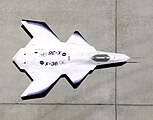Slika:McDonnell Douglas X-36 planform.jpg
Videz

Velikost tega predogleda: 783 × 600 točk. Druge ločljivosti: 313 × 240 točk | 627 × 480 točk | 1.003 × 768 točk | 1.280 × 980 točk | 2.560 × 1.961 točk | 3.060 × 2.344 točk.
Izvorna datoteka (3.060 × 2.344 točk, velikost datoteke: 1,77 MB, MIME-vrsta: image/jpeg)
Zgodovina datoteke
Kliknite datum in čas za ogled datoteke, ki je bila takrat naložena.
| Datum in čas | Sličica | Velikost | Uporabnik | Komentar | |
|---|---|---|---|---|---|
| trenutno | 22:00, 23. junij 2011 |  | 3.060 × 2.344 (1,77 MB) | Liandrei | {{Information |Description ={{en|1=Planform of the McDonnell Douglas X-36 tailless prototype jet, designed to fly without the traditional tail surfaces used on most aircraft.}} | |
Uporaba datoteke
Datoteka je del naslednje 1 strani slovenske Wikipedije (strani drugih projektov niso navedene):
Globalna uporaba datoteke
To datoteko uporabljajo tudi naslednji vikiji:
- Uporaba na cs.wikipedia.org
- Uporaba na en.wikipedia.org
- Uporaba na es.wikipedia.org
- Uporaba na lt.wikipedia.org
- Uporaba na uk.wikipedia.org
- Uporaba na vi.wikipedia.org




